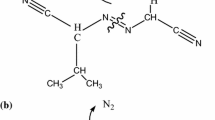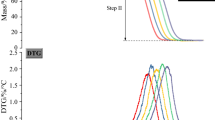Abstract
In this study, the thermal stability and thermokinetic parameters of 1,3-dimethylimidazolium nitrate ([Mmim]NO3) were investigated by thermogravimetric analysis under non-isothermal conditions in a nitrogen atmosphere. The results showed that [Mmim]NO3 exhibited three decomposition stages from 93.3 to 350.0 °C, and the onset temperature of [Mmim]NO3 was obtained at approximately 161.0–182.0 °C under five heating rates. The apparent activation energy was 119.0–124.0 kJ mol−1, as calculated by different well-known equations, and the pre-exponential factor was 3.6 × 1012 min−1. The reaction mechanism of [Mmim]NO3 was carried out with the reaction order n = 1.0, and the decomposition mechanism function was further obtained. Moreover, vent sizing package 2 was employed to acquire the maximum self-heating rate (39,828.0 °C min−1) and pressure rise rate (73,331.0 psig min−1) for simulating cooling system failure in a practical process. The findings indicated that [Mmim]NO3 showed the possibility of a runaway reaction, leading to a potential thermal hazard. The approach of these results is vital for obtaining inherently safer process information for [Mmim]NO3 during production, storage, and transportation.







Similar content being viewed by others
Abbreviations
- A :
-
Pre-exponential factor (min−1)
- E a :
-
Apparent activation energy (kJ mol−1)
- h :
-
Planck constant (J s)
- k :
-
Reaction rate constant (min−1)
- k B :
-
Boltzmann constant (J K−1)
- n :
-
Reaction order
- P max :
-
Maximum pressure (psig)
- R :
-
Molar gas constant (J mol−1 K−1)
- r :
-
Linear correlation coefficient
- T :
-
Reaction temperature (K)
- T end :
-
Termination temperature of decomposition (°C)
- T max :
-
Maximum temperature (°C)
- TMRad :
-
Time to maximum rate under adiabatic condition (h)
- T NR :
-
No return temperature (°C)
- T onset :
-
Onset temperature of decomposition (°C)
- T p :
-
Peak temperature of decomposition (°C)
- T start :
-
Start temperature of decomposition (°C)
- ΔG ≠ :
-
Gibbs free energy (kJ mol−1)
- ΔH ≠ :
-
Enthalpy (kJ mol−1)
- ΔS ≠ :
-
Entropy (J mol K−1)
- ΔP ad :
-
Adiabatic pressure rise (psig)
- ΔT ad :
-
Adiabatic temperature rise (°C)
- α :
-
Degree of conversion
- β :
-
Heating rates (°C min−1)
- Φ :
-
Thermal inertia
References
Sheldon RA. Fundamentals of green chemistry: efficiency in reaction design. Chem Soc Rev. 2012;41:1437–51.
Quraishi KS, Bustam QM, Krishnan S, Khan MI, Wilfred CD, Leveque JM. Thermokinetics of alkyl methylpyrrolidinium [NTf2] ionic liquids. J Therm Anal Calorim. 2017;129:261–70.
Wang HY, Jia YZ, Wang XH, Yao Y, Jing Y. Physical–chemical properties of nickel analogs ionic liquid based on choline chloride. J Therm Anal Calorim. 2014;115:1779–85.
Usula M, Plechkova NV, Piras A, Porcedda S. Ethylammonium alkanoate-based ionic liquid + water mixtures. J Therm Anal Calorim. 2015;121:1129–37.
Ren YL, Wang BY, Tian XZ, Zhao S, Wang JJ. Aerobic oxidative bromination of arenes using an ionic liquid as both the catalyst and the solvent. Tetrahedron Lett. 2015;56:6452–5.
Gharagheizi F, Sattari M, Ilani-Kashkouli P, Mohammadi AH, Ramjugernath D, Richon D. Quantitative structure–property relationship for thermal decomposition temperature of ionic liquids. Chem Eng Sci. 2012;84:557–63.
Maton C, De VN, Stevens CV. Ionic liquid thermal stabilities: decomposition mechanisms and analysis tools. Chem Soc Rev. 2013;42:5963–77.
Parajó JJ, Teijeira T, Fernández J, Salgado J, Villanueva M. Thermal stability of some imidazolium [NTf2] ionic liquids: isothermal and dynamic kinetic study through thermogravimetric procedures. J Chem Eng. 2017;112:105–13.
Souza RL, Ventura SPM, Soares CMF, Coutinho JAP, Lima AS. Lipase purification using ionic liquids as adjuvants in aqueous two-phase systems. Green Chem. 2015;17:3026–34.
Zhang ZH, Cui T, Zhang JL, Xiong H, Li GP, Sun LX, Xu F, Cao Z, Li F, Zhao JJ. Thermodynamic investigation of room temperature ionic liquid. J Therm Anal Calorim. 2010;101:1143–8.
Keshavarz MH, Esmaeilpour K, Saani MH, Taghizadeh H. A new method for assessment of glass transition temperature of ionic liquids from structure of their cations and anions without using any computer codes. J Therm Anal Calorim. 2017;1:1–19.
Zhao YS, Zhen YP, Jelle BP, Bostrom T. Measurements of ionic liquids thermal conductivity and thermal diffusivity. J Therm Anal Calorim. 2017;128:279–88.
Sharma VK, Kataria J, Bhagour S. Thermodynamic investigations of 1-ethyl-3-methylimidazolium tetrafluoroborate and cycloalkanone mixtures. J Therm Anal Calorim. 2014;118:431–47.
Smiglak M, Reichert WM, Holbrey JD, Wilkes JS, Sun LY, Thrasher JS, Kirichenko K, Singh S, Katritzky AR, Rogers RD. Combustible ionic liquids by design: is laboratory safety another ionic liquid myth? Chem Commun. 2006;24:2554–6.
Cao YY, Mu TC. Comprehensive investigation on the thermal stability of 66 ionic liquids by thermogravimetric analysis. Ind Eng Chem Res. 2014;53:8651–64.
Wellens S, Thijs B, Binnemans K. How safe are protic ionic liquids? Explosion of pyrrolidinium nitrate. Green Chem. 2013;15:3484–5.
Anouti M, Cailloncaravanier M, Floch CL, Lemordant D. Alkylammonium-based protic ionic liquids. II ionic transport and heat-transfer properties: fragility and ionicity rule. J Phys Chem B. 2008;112:9412–6.
Smiglak M, Hines CC, Reichert WM, Vincek AS, Katritzky AR, Thrasher JS, Sun LY, McCrary PD, Beasley PA, Kelley SP, Rogers RD. Synthesis, limitations, and thermal properties of energetically-substituted, protonated imidazolium picrate and nitrate salts and further comparison with their methylated analogs. New J Chem. 2012;36:702–22.
Diallo AO, Fayet G, Len C, Marlair G. Evaluation of heats of combustion of ionic liquids through use of existing and purpose-built models. Ind Eng Chem Res. 2012;51:3149–56.
Grigiante M, Brighenti M, Antolini D. Analysis of the impact of TG data sets on activation energy (E a). J Therm Anal Calorim. 2017;129:553–65.
Kissinger HE. Reaction kinetics in differential thermal analysis. Anal Chem. 1957;29:1702–6.
Starink MJ. A new method for the derivation of activation energies from experiments performed at constant heating rate. Thermochim Acta. 1996;288:97–104.
Fredlake CP, Crosthwaite JM, Hert DG, Aki SNVK, Brennecke JF. Thermophysical properties of imidazolium-based ionic liquids. J Chem Eng. 2004;49:954–64.
Wendler F, Todi LN, Meister F. Thermostability of imidazolium ionic liquids as direct solvents for cellulose. Thermochim Acta. 2012;528:76–84.
Huddleston JG, Visser AE, Reichert WM, Willauer HD, Broker GA, Rogers RD. Characterization and comparison of hydrophilic and hydrophobic room temperature ionic liquids incorporating the imidazolium cation. Green Chem. 2001;3:241–72.
Awad WH, Gilman JW, Nyden M, Harris RH, Sutto TE, Callahan J, Trulove PC, De Long HC, Fox DM. Thermal degradation studies of alkyl-imidazolium salts and their application in nanocomposites. Thermochim Acta. 2004;409:3–11.
Arellano IHJ, Guarino JG, Paredes FU, Arco SD. Thermal stability and moisture uptake of 1-alkyl-3-methylimidazolium bromide. J Therm Anal Calorim. 2011;103:725–30.
Valkenburg MEV, Vaughn RL, Williams M, Wilkes JS. Thermochemistry of ionic liquid heat-transfer fluids. Thermochim Acta. 2005;425:181–8.
Gray P, Griffiths JF, Hasegawa K. Nonisothermal decomposition of methyl nitrate: anomalous reaction order and activation energies and their correction. Int J Chem Kinet. 1981;13:817–31.
Gray BP, Rogers GT. The explosion and decomposition of methyl nitrate in the gas phase. Trans Faraday Soc. 1954;50:28–36.
Vyazovkin S, Burnham AK, Criado JM, Pérez-Maqueda LA, Popescu C, Sbirrazzuoli N. ICTAC Kinetics Committee recommendations for performing kinetic computations on thermal analysis data. Thermochim Acta. 2011;520:1–19.
Yi JH, Zhao FQ, Gao HX, Xu SY, Wang MC, Hu RZ. Preparation, characterization, non-isothermal reaction kinetics, thermodynamic properties, and safety performances of high nitrogen compound: hydrazine 3-nitro-1,2, 4-triazol-5-one complex. J Hazard Mater. 2008;153:261–8.
Semenov NN. Some problems of chemical kinetics and reactivity, vol. 2. Oxford: Pergamon Press; 1959. p. 330.
Acknowledgements
The authors would like to express their appreciation to the Anhui Province Education Department Natural Sciences Key Fund, China, under the Contract Number KJ2017A078, as well as the donors of the Anhui University of Science and Technology, China, under the Contract Number QN201613 for financial support of this study.
Author information
Authors and Affiliations
Corresponding author
Rights and permissions
About this article
Cite this article
Zhang, B., Liu, SH. & Chi, JH. Thermal hazard analysis and thermokinetic calculation of 1,3-dimethylimidazolium nitrate via TG and VSP2. J Therm Anal Calorim 134, 2367–2374 (2018). https://doi.org/10.1007/s10973-018-7557-4
Received:
Accepted:
Published:
Issue Date:
DOI: https://doi.org/10.1007/s10973-018-7557-4




